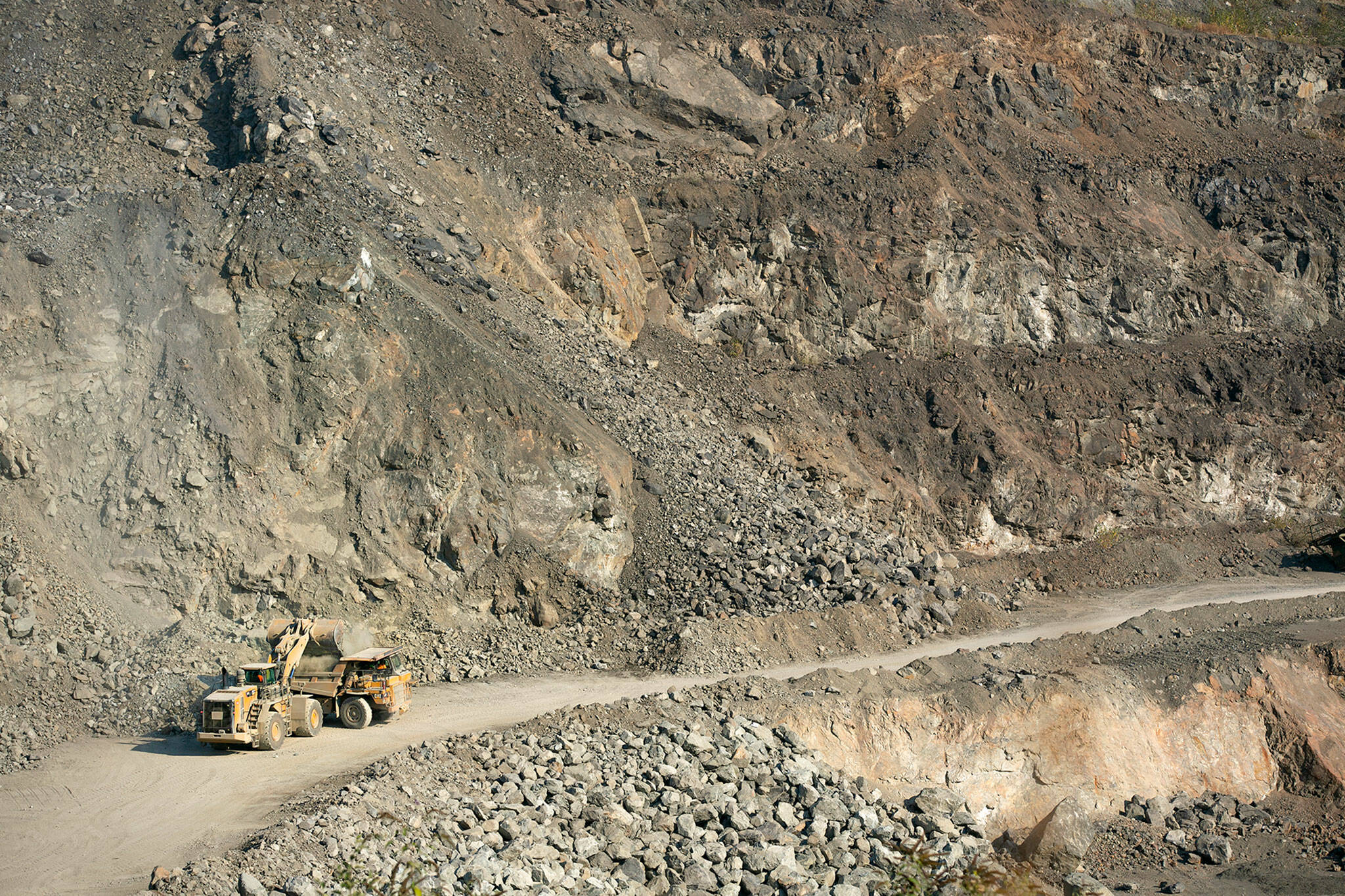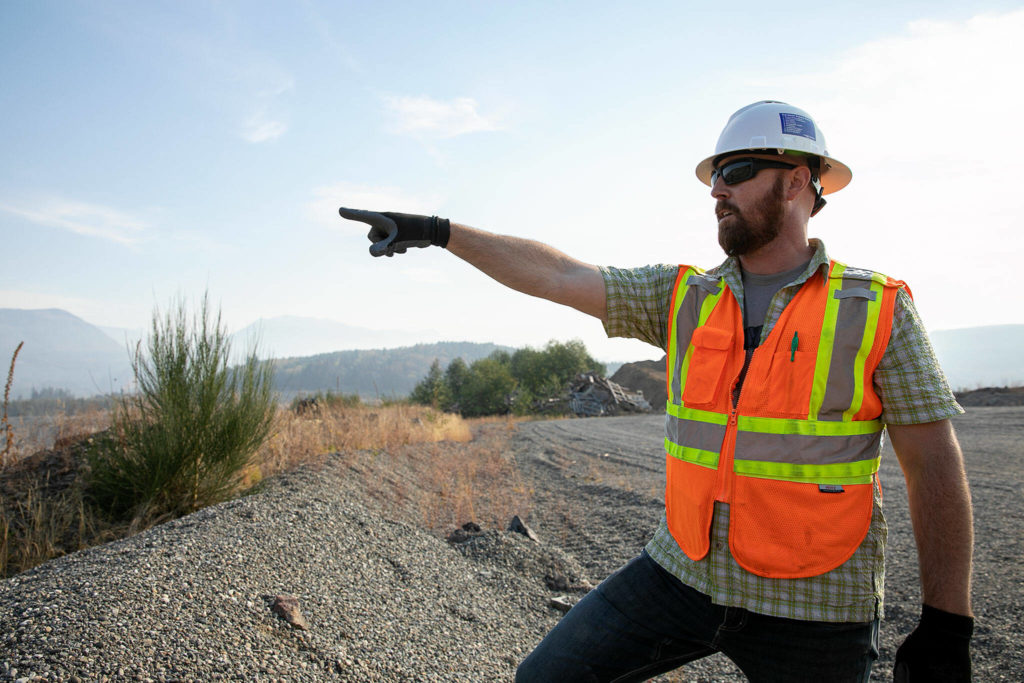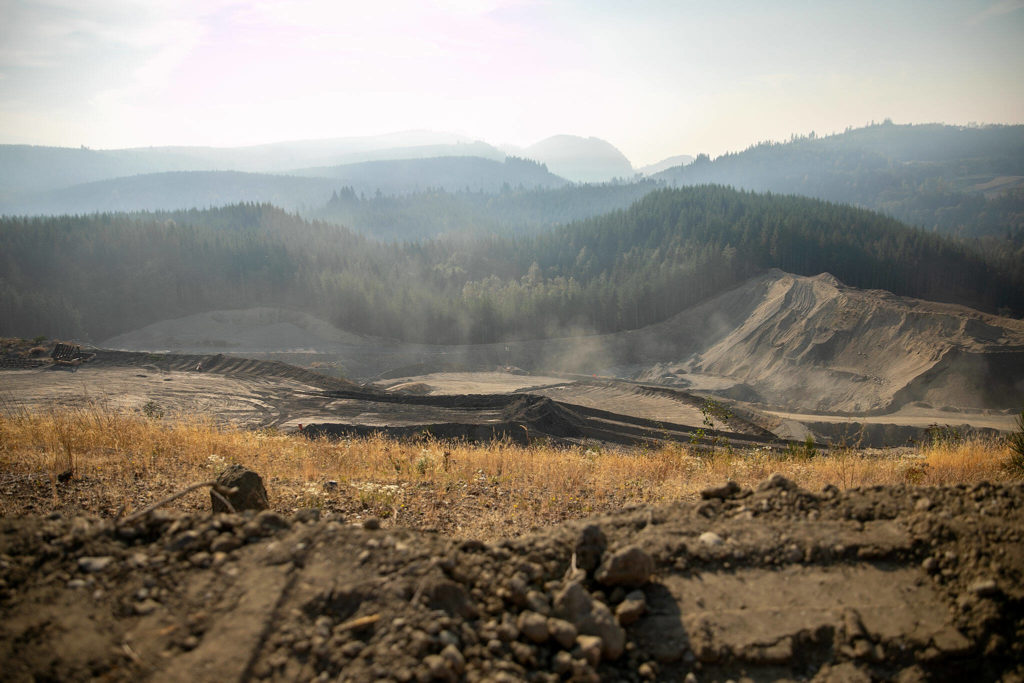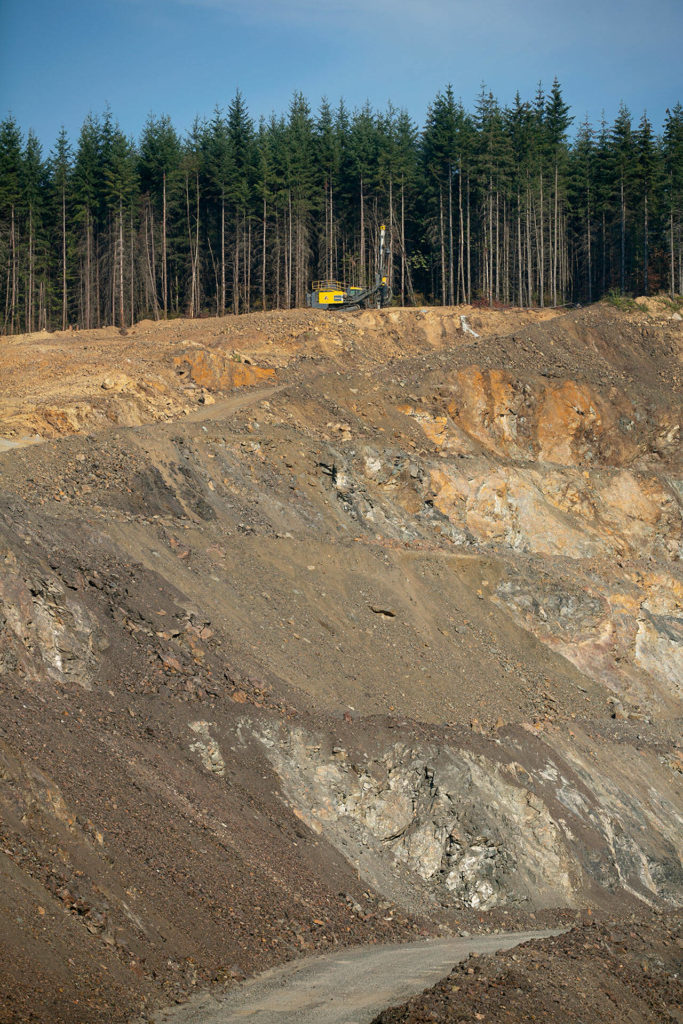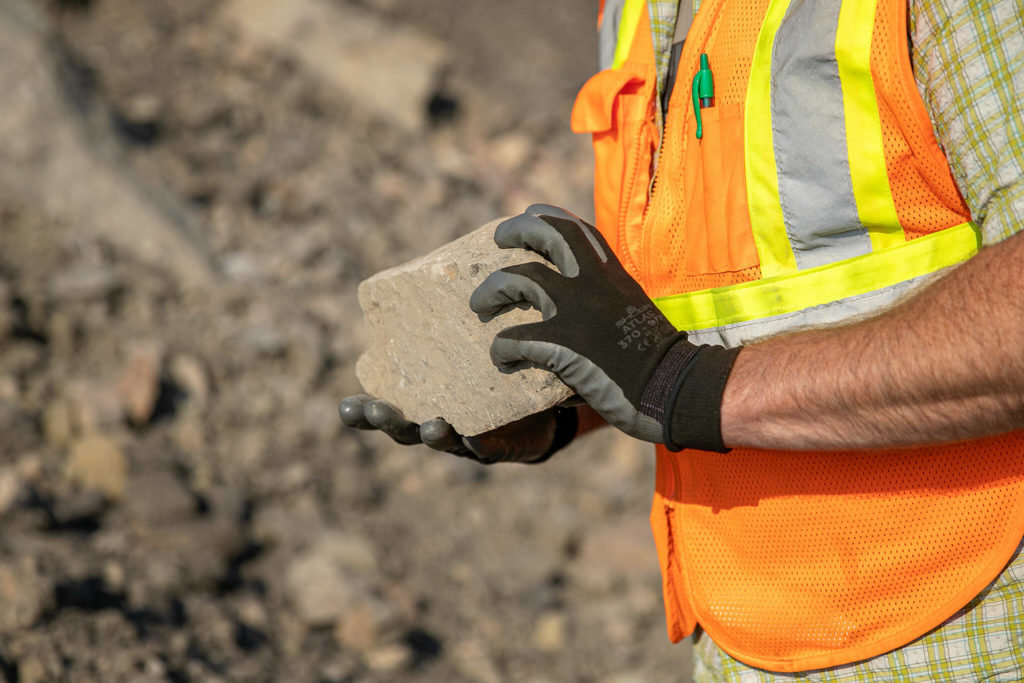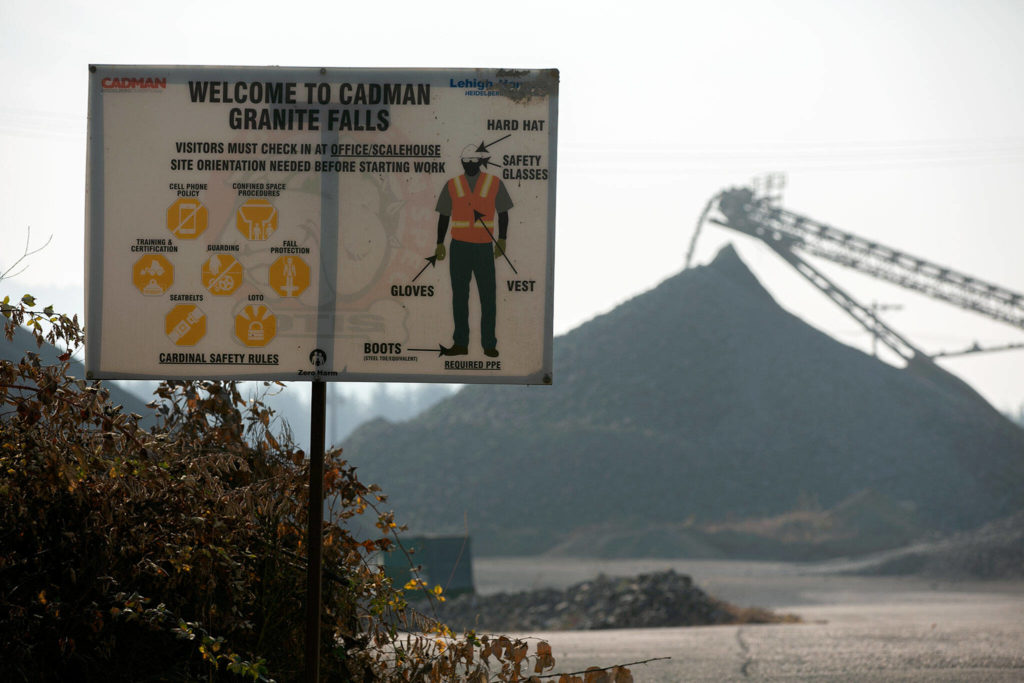GRANITE FALLS — A gravel mine that has operated for almost 25 years in Snohomish County is seeking to expand by 56 acres. Some neighbors have questions about truck traffic, noise and impacts to well water.
Cadman operates the 425-acre sand, gravel and crushed stone mine off Mountain Loop Highway northeast of Granite Falls, outside city limits.
Last week, machines sorted rocks by size into piles. A truck fed large stones into the “jaw crusher” to break them up. The materials will be used for roads, railroads and other construction projects, explained Eric Parthemore, Cadman’s aggregates operations manager.
Parthemore drove to a vantage point overlooking Cadman’s 205-foot-deep quarry, where the company mines bedrock tens of millions of years old. Trucks scooped up broken rocks on 40-foot-tall platforms called “benches.”
Now, Cadman wants to expand the quarry to keep mining another 25 years. The expansion would add 42 acres west of the existing quarry and 14 to the north.
“The expansion allows us access to more material,” Parthemore said. “We’re not going to mine at a higher rate or increase our production.”
He said there is no expected increase to either truck traffic or rock blasting from the expansion.
The company needs a new conditional-use permit, because the current expires at the end of 2024. It plans to apply to Snohomish County for the permit later this fall. If approved, the permit would last another 25 years.
Cadman is part of Lehigh Hanson, owned by publicly traded Germany company Heidelberg Materials. The Granite Falls mine employs about 25.
Some neighbors received an invitation to tour the mine on Sept. 29. Tina Day and her mother Pamela Day, who both live across the street, were two of about a dozen neighbors who attended the tour.
Tina Day told The Daily Herald trucks start lining up at 6:30 a.m. to pick up gravel loads. She worries about the affect of double-bedded gravel trucks on roads and a nearly 90-year-old bridge.
Granite Falls Bridge 102, which crosses the south fork of the Stillaguamish River, is a lifeline for residents.
Pamela Day said if the bridge failed, “we could be stranded here and have no way for the medic or fire department to come in.” The only other route is the long way on the potholed Mountain Loop Highway. And sections are closed in the winter.
Pamela Day was relieved to learn of plans to replace the bridge, a long-awaited project moving forward thanks to a $22 million federal grant announced last November.
The bridge is also critical for mining and logging industries. On average, it sees 830 freight trucks a day, said Julie Kuntz, a spokesperson with Snohomish County Public Works. Trucks account for about 13% of daily traffic.
Jon Olsen, another neighbor, shared concerns about the bridge.
“I realize they are not ramping up trucks going in and out, but at what point will that 88-year-old bridge have no more and we’ll be stuck here in Granite Falls?” he said.
Construction on the replacement bridge is expected to begin in 2026.
The Cadman mine is not running at maximum capacity. A 1992 traffic study expected as many as 556 daily truck trips.
In 2018, there were an average of 338 daily trips, when the mine produced about 1.3 million tons, said Melanie del Rosario with Veda Environmental, a consultant working with Cadman. She said the mine processed fewer materials the past three years, resulting in fewer truck trips.
For wear and tear on roads, Cadman pays both the city of Granite Falls and county quarterly fees.
Blasting, which uses explosives to break up rock, is another issue for neighbors.
“It’s disturbing. It seems like there is a bomb going off,” Tina Day said. “You can hear it, it shakes, and they don’t notify people.”
The Pacific Northwest Seismic Network has recorded seismic activity at the mine. Of three seismic events recorded in the past year, all were 1.3 magnitude or less, according to the network.
Parthemore estimates Cadman conducts between six and 12 blasts a year. The expansion won’t increase the size or number of blasts, he said. There are plans, however, to start notifications: texts and emails to neighbors and a sign posted at the entrance before a blast.
“Our goal is to be the best neighbor we can be,” he said.
Olsen, who is vice president of the River & Forest Heights homeowners association, also had questions about how blasting impacts water quality in his well.
Parthemore said the company does groundwater sampling throughout the mine, and that the expansion shouldn’t affect wells.
Several other companies operate gravel mines near the aptly named Granite Falls. Historically, city residents had to put up with hundreds of trucks a day rumbling through downtown. That is until a 2-mile bypass road was completed in 2010 to divert trucks away from city streets. The new route changed life “overnight” for residents, Granite Falls Mayor Matt Hartman said.
Hartman, who attended the tour on Sept. 29, noted the mine has changed ownership several times.
“I feel that most (owners) have been good stewards,” he said.
Once mining is complete, operators restore sections of land, called reclamation. For example, mines may be converted back to forest or wetlands. Parthemore said reclamation can begin in one area while mining continues in another.
A “neighborhood quarry committee” will meet Nov. 1 to discuss the permit at Granite Falls City Hall. The group will include representatives of homeowners associations, Cadman, the county and a member of the Granite Falls City Council.
More information is available at cadmangranitefalls.com.
Jacqueline Allison: 425-339-3434; jacqueline.allison@heraldnet.com; Twitter: @jacq_allison.
Talk to us
> Give us your news tips.
> Send us a letter to the editor.
> More Herald contact information.
